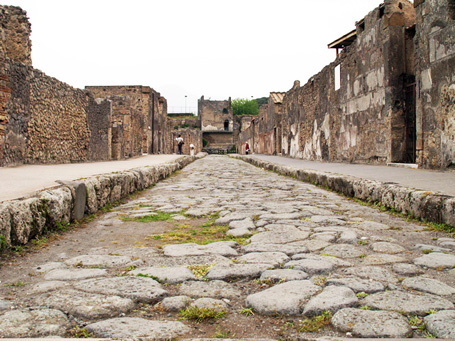Such is the book’s historical appearance that when Lytton strays into the realms of pure fantasy, as in his macabre descriptions of the mansion belonging to the pagan priest Arbaces, most of his contemporary readers will not have been aware of the book's continual deviation from historical fact. On the other hand, today’s readers who are familiar with 50s horror films, will recognise in Arbaces’ mansion the Egypto-Gothic spires and gargoyles that were the ingredients of so many later horror films. In actual fact Pompeian houses, even those of the wealthiest, bore few external distinguishing characteristics. This was largely due to their inward orientation that facilitated better climate control, social cohesion and security. Arbaces’ tree shrouded secluded mansion, whilst understandable from a dramatic point of view, bears no relationship to Pompeii. Space within the walled city was at a premium and no house was secluded (fig.1). In addition to seemingly historical settings Lytton also manipulates the reader’s emotions by means of four main character stereotypes. The Greek hero, Glaucus, who is a rich young 'dandy', Ione the heroine, a beautiful virgin, Nydia, her blind servant-girl, and finally the evil Arbaces, a priest of Isis, who lusts after Ione. Of all the characters his is the most developed and much of the story revolves around his attempts to discredit Glaucus and seduce Ione.
Throughout the novel exteriors and interiors are carefully manipulated in order to provide backdrops that endorse the plot. Hence, for example, the interiors of the two main protagonists, Glaucus and Arbaces, are diametrically opposed. The hero’s is graceful, light and airy, whilst that of his counterpart, Arbaces, borders on the type of demonic mansion found in a Bram Stocker novel. Although house sizes and contents varied according to patterns of wealth, Pompeii was surprisingly homogenous, and sophisticated wall-paintings also existed in relatively small houses. Biographic details indicate that Glaucus and Arbaces represent two distinctly different aspects of Lytton’s character. Glauces appears to mirror his belief in the importance of noblesse oblige, dispensed by disinterested aristocratic dandies such as Lytton himself, whilst the priest of Isis mirrors his darker side. Lytton used Arbaces to reinforce contemporary Christian concerns regarding the evils of paganism, whilst at the same time using him to indulge his interest in occult practices and psychic phenomena. References to ancient mystical rituals and magical practices constantly surface through the book. According to Leslie Mitchell’s biography Bulwer-Lytton: The Rise and Fall of a Victorian Man of Letters, Lytton was very sensitive to the fact that his involvement with psychic practices exposed him to public ridicule, something he dreaded as a writer and perhaps even more significantly as a politician. (Mitchell 2003: 142)
The distorting effect of Last Days was highly significant because Lytton was one of the most prolific and widely read English novelists of his day, in addition to being a Member of Parliament and a Cabinet Minister in Queen Victoria’s Tory government (fig.2). Once described as England’s greatest living novelist, he is now either ignored or ridiculed for having written the worst opening line of any novel.
“It was a dark and stormy night and the rain fell in torrents – except at occasional intervals, when it was checked by a violent gust of wind which swept up the streets (for it is in London that our scene lies), rattling along the housetops, and fiercely agitating the scanty flame of the lamps that struggled against the darkness.” (Paul Clifford 1830)
 1
1
|